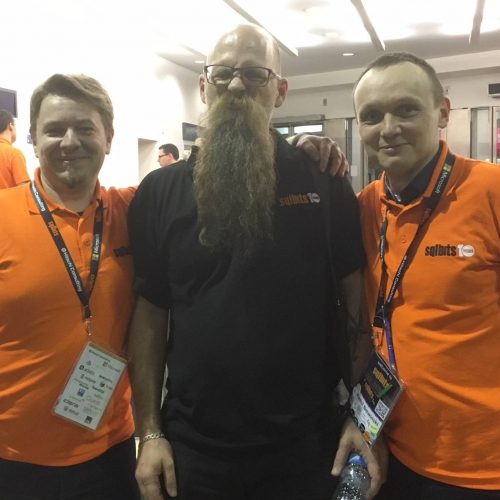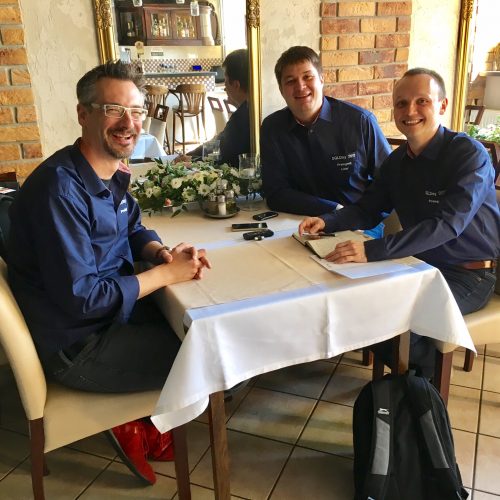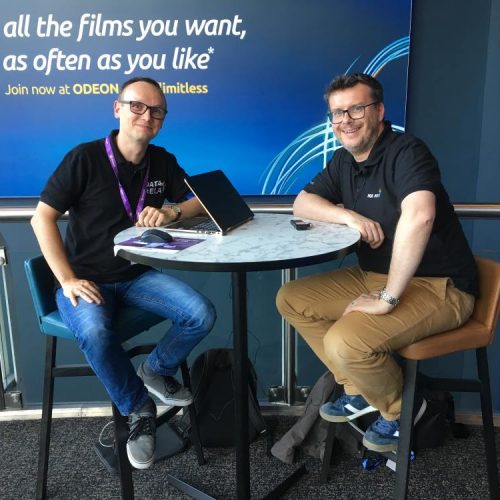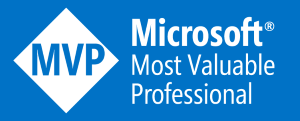ASF 009: Pedro Lopes interview
Introduction
Pedro Lopes is a Senior Program Manager in the Database Systems Group, based in Redmond, WA, USA. He over 15 years of industry experience. He is currently responsible for Program Management of database engine features for in-market versions of SQL Server, with special focus on the Relational Engine.
He also works closely with several Tier 1 SQL Server customers, as well as partners in the field, to understand and gather information about product usage and feedback to drive improvements into the product. Prior to this role, he was a Premier Field Engineer based in Europe for several years.
He has deep understanding and experience in various features of the product spanning several versions of SQL Server, starting with SQL Server 7 and up to and including SQL Server 2016.
This talk has taken place during PASS Summit in Seattle, WA, on 3rd November 2017 (Friday).
Why working for the Tiger Team is so fascinating? Why Pedro started to love the data? How to start to be a community leader? Is sharing knowledge an important thing? What does Pedro proud of the most?
Check these answers out in this episode.
Transcript
Kamil Nowinski: Hello Pedro.
Pedro Lopes: Good morning Kamil, how do you do?
KN: Very good, very good.
PL: Nice to see you again.
KN: You too, thanks! So this is the last day of PASS Summit. We are in the Microsoft Clinic stand. Could you introduce yourself?
PL: Sure, so my name is Pedro Lopes and I am a Program Manager with the SQL Server Tiger Team. For those that don’t know the Tiger Team owns the in-market versions of SQL* and we can act with the customers to make them successful and platform which means doing a lot of reactive work – fixing bugs, issuing service packs, but also doing the proactive work helping shape architectures, write best practice articles and we also own a lot of documentation for in-market version. So in nutshell, that’s what I do as part of that team.
Me specifically, I own the relational engine for the in-market versions which means everything that makes your queries “tick” if you will. And I mainly enjoy performance troubleshooting and performance tuning.
KN: Ok, tell me where are you living? You are working for Microsoft in Redmond, yes?
PL: Yes.
KN: Where are you living? In some area?
PL: It’s close. It is 12 miles from here. It was snowing this morning actually, which is nice…
KN: Yes, it is freezing this morning.
PL: It was actually snowing there which is not common where I live. But it was a nice surprise
KN: OK.
PL: Yes, but I am living close enough to Redmond campus.
KN: OK, tell me how long or from which version do you work with SQL Server?
PL: Oh gosh… So I have been working with SQL Server only since 2002. Actually, it’s been some years now. Coming to think about it. But when I started, I started with SQL Server 2000 but I had still SQL Server 7 laying around. And I guess that were a couple of SQL Server 6.5 laying under some desks, so basically that’s how I started.
Damian Widera: Pedro, how do you think how tough or how easy it is for you to adopt to new versions of SQL Server, because right now we have a new SQL Server let’s say every two years, and maybe even more frequently?
PL: Yes, so definitely the release cycles are shortening. If you think of it, it only took around 16 months between the time we released SQL Server 2016 to releasing SQL Server 2017.
DW: Exactly.
PL: And that has to do like it was said in the keynote and in several other sessions, that has to do with keeping up the pace of innovation, right?
If you would have to wait three years, four years for a new version that comes with everything that has been developed in the previous years, you as a SQL Server user, are losing a lot of what is happening in the data world. For example, using R algorithms over the data on SQL Server. You do not have to move data out. That is extremely powerful.
Or now to use the interesting use of polybase. So imagine if it take years to be able to adopt to what is becoming an industrial standard, and you as a company using SQL Server would be left behind. So indeed, times are changing in that perspective
KN: Yes. And the IT require very fast adopt the new features…
PL: True. We grant you that there are let’s say a few frictions. For example, when we changed, when we implemented the new cardinality estimator in the SQL Server 2014 and people were upgrading, that generated some frictions. So for the majority of workloads that actually work very well, but there are few occasionally regressions and we understand that. Now with SQL Server 2016 and now 2017, and the use of the Query Store, and the automatic plan regression that’s taken care automatically for you. So you as a production DBA don’t need to really care that much about that specific anymore.
So you can upgrade more confidently, let’s say from SQL Server 2012 or 2014 to SQL Server 2017, take advantage of Query Store using automatic plan regression, and if any regressions happen you do not need to decide “oh, should I go to the trace flags or setting that turns my server back to old CE”. No. Whatever query has issues they will be fixed by using a previously known good version of the plan. But that leaves still something on the table for you as a DBA, because you still need to go in, understand (using a number of tool as I have demonstrated during my sessions here), find out what’s not good and why it’s regressed. And then do the necessary work with your developers to make sure the query works natively in whatever is the new compatibility level.
But the point is that in production you don’t need to live with the nightmare that maybe a part of my important workload regressed, and now what do I do?
KN: Yes. So from that perspective we will need the developers but we will not need the DBAs?
PL: I disagree. Because here is the thing. It is, in my perspective part of the DBA… So there are two main aspects here:
Yes, if you have developed your career doing a performance tuning some of the more menial tasks might be the taken care of for you. Now for example, the practical result of regressed workload, let’s say when you move from SQL Server 2012 to SQL Server 2017 is, let’s say 20% of my workload. Because sometimes two wrongs make right, it worked better, although it was not necessarily a better plan, but it worked better from a standpoint, in a previous version. And now moving to the SQL Server 2017, because that can be detected and corrected automatically, you as a DBA don’t need to do that part. But you still need to provide a root cause for the change. You still as an experimented DBA, need to provide mitigation steps and actually more than that. Resolutions – to make sure that the queries you take, tune them to work natively, in let’s say SQL Server 2017 version or whatever you are using, and then you will be able to do away with the mitigation that automatic plan regression implemented because now you are running – in the better shape – in the native version of the compiler.
KN: So the DBAs should not be worried about their future?
PL: I don’t think they should. And by the way. With all those new technologies coming in to the SQL Server ecosystem like polybase and R and others, you have more diversity. So, it is an ever changing world – yes, but it’s also a world that allows you to learn something new and keep yourself relevant, if you will.
KN: Yes.
DW: Yes, and this is a great explanation because for example, what I have heard from customers and people that occasionally just look at the system, they were thinking that really we don’t need the administrators. But it is exactly like you explained. The role is changing, is evaluating, and it might not be simple tasks in a moment. They will be different tasks. So maybe you don’t have to know everything about tuning, because you have now better tools, but other things still, or other features still require DBA and people who understand what’s going on in the system.
PL: Absolutely. I agree with you.
KN: Pedro, tell us, what specific tools are you using during your work?
PL: To be honest I am a huge fan of SSMS. Being a user of the SSMS for years obviously, and I have used tools from ours partners, which are doing an excellent work in leveraging all the diagnostics artifacts we are putting into the engine with their own tools is great, we are not competing with anyone – let me be very clear. But with all the, because I work a lot with performance tuning and query performance troubleshooting, I am big user of the SHOWPLAN and many things that evolves around making SHOWPLAN a one stop shop for everything you need to know about the query execution. The context on which it executed, because we have added information about statistics loaded, we have added information about the trace flags active to the system, everything you need to know about the context of the execution of a query. But then we have added a lot of performance metrics of each operator in the plan. So all of that is… we’ve been working with customers, with users, and we ourselves are users of the tools in order to troubleshoot and help our own customers. So right now we’re releasing a new tool as you know.
KN: Yes, I wanted to ask about it. It will not replace the SSMS, yes?
PL: Right away no it will not. Let’s be very clear. So, our investments will go into that multiplatform tool, absolutely. We are not at a point, because the tool (which was actually explained yesterday by Ken who is the engineering manager in the team that owns that tool), that the source code will be published to GitHub. And we will call upon the community to help improve the tool because it’s basically a front end for a collection of microservices. So at this point of time, for example for the scenarios I was talking about, which is deep query troubleshooting and some tools that we have embedded over the last years to the SSMS, they are not available in the new tool. They will be in the due time and that can happen faster or not, also with the community helping. Because users with enough skills to know what they want out of the tool, will be able to contribute to its success. I think it makes a much better outcome. So, in a nutshell, the SSMS will not be deprecated yet, because there is no …
KN: Replacement…
PL: … complete replacement. But yes, it’s true that our investments will be further onto the new tool, because it’s multiplatform, right? And because it can leverage help from the community, whereas SSMS…
KN: Remind me the name of the new tool?
PL: It’s Microsoft SQL Operations Studio. Sorry, I am still getting used to the name.
KN: Yes.
PL: It is MSOS. **
KN: Yes, MSOS.
PL: I know the acronym. It is the Microsoft SQL Operations Studio.
KN: So for this application everyone can be engaged in developing this project?
PL: Yes, so the source code will be made available in GitHub shortly. The preview as far as I know start in mid-November. We will release a preview so everyone can start to use it. And again, it’s the rich environment when the user will point out what he needs out of the tool, maybe it’s comparable with SSMS and maybe it’s getting something new that SSMS never had. And being able to provide a feedback and better yet if he has a skillset to actually submit changes to GitHub and improve the tool on his own, then let the community leverage all of that. I think that’s the best world we can be in.
KN: Yes, it’s really great idea I think.
DW: OK, Pedro, what do you think about MVP those days. About the program and people. How the see it?
PL: They are all great partners. That’s what I can tell you. We have, as you might now, a direct feedback channel from MVPs, because we share a DL (distribution list) with them. The MVP community is both a hardcore user of SQL Server that pushes SQL Server to its limits. They in fact, many MVPs are themselves consultants as they work for our end customers in terms of SQL Server. They do provide a bridge to those scenarios and to the feedback that’s stands from that. And then, just giving us honest feedback, that we use in order to improve the product, because that is how we have been doing it for more than two years now. We build what the users want to use. We don’t build anything hoping someone will adopt it.
KN: Exactly, that will not make any sense, that approach.
PL: Yes.
KN: Let’s talk about you as a person. Not only from a professional view but also from a personal point of view. What is your hobby? Do you have any hobby?
PL: Hobbies. Yes, I do. I am huge movie fan. I devour movies. I have my own collection of movies. Blu-rays, DVDs… I am an old school. I have never gone to the fad of downloading movies from the internet. I really go and buy movies on blu-rays and DVDs.
KN: It’s still not very old school. If you told me you have tapes aor something like this that would be very old school.
PL: People say it’s strange that I do that and not just download the versions that’s made available or just sign up to Netflix or Hulu or something like that. No, I still like to get, to sort them alphabetically, yes, it’s like an index sitting in my shelve. Over 1600 DVDs and Blu-rays. Yes, that’s one of the thing I do. And I also collect a movie memorabilia.
KN: And what is the movie memorabilia?
PL: Artifacts that were other used in films or are representative of films like statues, or props used in movies, or stuff like that.
KN: Oh, ok.
DW: So that’s really a hobby and I think also your passion…
PL: Absolutely.
KN: Yes, it’s also work like this. What do you think about your work-life balance?
PL: My what?
KN: Work-life balance. This is a currently very common phrase. You know – how to …
PL: Kamil, thank you, let me drop you there. I know what a work-life balance is. I was just… It’s variable. It varies. Sometimes it balances more to the work and sometimes it balances more to the life. That’s what I can tell you.
KN: Ok, fine.
DW: So I expect you are a very busy man also, working for Microsoft that must be a lot of tasks every day you have to deal with
PL: So like I said, I work in a team that is outwards facing. Our main mission is to help customers become successful with SQL Server. That takes a lot of facets if you will. That includes for example, a customer open cases with the CSS and they find bugs, for example in some edge cases. Let’s remember that SQL Server runs on millions of servers, with billions of different workloads, and it needs to adequate, adapt to all of them. Now it’s bound that you find edge cases where the server misbehaves or even hits bugs, right? So that’s the part of the work we need to work with those customers to make sure that we unblock them as fast as possible, and make them successful with the platform they are using.
But also in, for example, in learning from those interactions and seeing what we can implement at tools level or the engine level, to make sure that once you hit a blocker for you, which might not be a bug, and may be a performance issue or something like that, you have the tools and the artifacts in the engine to quickly identify and take you away from the problematic place, right? And that’s a huge part of my work, specifically as I said in the beginning, within the Relational Engine.
DW: So it must be really very fascinating because you have feedback from people that are using it, using the engine, the SQL Server. They use it in a very different ways, and you see how the work done by Microsoft is consumed by people. So probably you will never get bored at work.
PL: Yes, I can tell you, there’s never a boring day.
DW: Yes, I can imagine. My question would be that, imagine that you are speaking to students. What would you tell them as you know they are going to start their careers in IT market? What should they choose? Do you have any advices for them? How should they start, how should they build their careers?
PL: That’s a tough question and I don’t have a definite answer. If I can give any advice, would be stay open minded, be conscious that even if you have 20 years of career or just starting you will learn every day, and be open to learn every day. Technology changes around us at an incredible pace. And keep up, find your space and thrive in it. Leverage the work of others. Collaborate, work as a team. I guess, keeping up the students’ spirit throughout the rest of your career. I think it would be my advice here. What technical area to choose? I personally love databases but I don’t expect everyone to work with that.
KN: Let me rephrase the question then. How you started as a young man in the IT, and or maybe how it happened that you started working for Microsoft?
PL: Oh my god…
KN: I hope you remember that…
PL: Yes, fairly well. I started working with SQL Server by accident. I always working with technology, I started when I was in high school. Then moved to a college. But the point is that actually in college I majored in something different but then went back to IT and to computer programming. What I was going to say is I, I’ve got to working with databases by accident, starting actually with SQL Server 2000 and early versions of Oracle, and then I found that I loved to being able to model data, to answer business questions, by understanding how to model data to provide those answers, and I got hooked ever since. Working for Microsoft, well I am on my eight year at Microsoft, and as you would, I saw an ad and I applied and ran my course of interviews, and one leads to the other, and eight years later I am here. Working with stuff I love every day.
KN: Ok, great! You are making a lot of speeches across the conferences. So how you prepare yourself for the speech.
PL: There are two main schools of preparedness if you will. There are those who prepare a month in advance and they lock down their sessions and demos, and everything is lock down a month beforehand. I don’t belong to that club. However, I do keep an updated, let’s say, master collection of topics I am passionate about and I like to talk. And when I am preparing to a conference I pull them together let’s say two weeks before. Maybe I’ll refresh the demos, and sometimes I refresh the demos minutes the session starts.
KN: Oh, no
PL: Because sometimes you have something you would like to show and do those. I rehearse the demos from time to time just to make sure they flow, but sometimes impromptu to I just show some more detail that I was anticipating, or something also depending on how the questions I am getting and how people reacting on them. So, there is a some degree of preparedness and some degree of improvisation.
KN: Damian, any comments, question?
DW: Yes, yes, because I also do some speeches as well and nowadays I cannot somehow imagine that you can be prepared like months before for a conference. Because everything is changing especially in the cloud. So in the Azure you could be very surprised that there a lot of new features you have not expected to be there. So I think we have to be very …we have to change things almost every day or a week. In best case every month. But maybe we can ask you about something else. Do you have any animals at home?
PL: Do I have any what, I’m sorry?
KN: Animals.
PL: No, I don’t, my kids are begging me for a pet dog and I am almost breaking, so possibly very soon.
DW: Dogs you know are very good for kids. I have two and two cats and they are playing together
PL: Yes, but they don’t take care about themselves.
DW: No…
PL: Now that my kids are old enough to be responsible. The tradeoff will be if getting a pet, you are mainly responsible for them. If they accept that then ok.
KN: They are playing together and destroying together everything
PL: yes, that I hope won’t be happening that often, but will cross that bridge if it comes to it, Kamil
KN: Ok, the next question is which achievements are you satisfied the most, of your private or professional life?
PL: Oh, I am super proud of my kids and everything they do every day. That’s on the personal aspect the greatest achievement. And I think their mother, my wife, has much more credits on that than I do. Having said that professionally I can’t put my finger on one thing. Again, I am working with a fantastic team and fantastic people. I am learning every day and hopefully I am contributing something. I really can’t point to anything specific. Every release, every CU, I’m proud that we are doing the work that customers expect from us. And that’s what fulfills me at the end of the day.
KN: I can notice that you use the Twitter as a way of communication. Are you fan of Twitter or why you choose that way of communication?
PL: Well, in that case I am not a… I am just a follower. So I know that community is fairly active on Twitter. Especially during the conferences. And it gets immediate attention but it also fades away very quickly. I would say I am not a heavy user of Twitter. I use it as another means to try to evangelize the work that we have been doing, and with that tried to help people to take an advantage the improvements they may expect from the work you are doing.
DW: Ok, I would like to get back to some work stuff. What do you think about passion at work? Because from my perspective, if you love what you do at work and it is really a passion you really can have many, many successes, almost every day. Do you think the same?
PL: I would agree. You have your personal satisfactions if you will. I loved when we were able to show the world Plan Comparison and Plan Analysis. And I loved when we were able to demonstrate to the community, the ways they might use the small changes that we have put in, because the community demanded us to. And that drives a sense of satisfaction.
KN: Is this an answer to your question Damian?
DW: Yes, of course!
We have a great community in Poland, DataCommunity, which also organizes a SQLDay conference as you can remember. And is there any specific advice you could say to people who would like to start doing their talks during the community meetings? Because we have a lot of leaders like Kamil, me and other great guys in Poland but sometimes we see people that would like to tell something but they somehow don’t want to go on stage and talk to other people. Do you have any advice? How to start? How to not be scared?
PL: I would say, start by talking that is towards to you. If you work with the technology and you and you faced challenges before, share with the community how you overcome them. Others possibly have faced the same, and they would welcome the lessons that you have learned and how you have overcome them. I would say that’s an excellent way to start sharing with the community and about a stage fright, that it is something I cannot help with to be honest. Just take a deep breath before the plunge and go for it. The community is like a SQL family. No one will grill you for attempting to share with the community. Everyone will welcome that. So don’t be afraid from sharing what’s close to you. What you think others can leverage, because in all honesty, if you faced a challenge before, it’s possible that others out there are now facing that challenge, and you will be able to help them.
DW: Yes, and that’s our role as leaders. We have to try to build the community and support possibly new leaders or people who like to share the knowledge. My thinking about it that people sometimes don’t want to speak, don’t want to talk to other people because they think their knowledge is not at the appropriate level.
PL: I would say that this is human – thinking that. I would also challenge you to say “if you don’t share and gauge your knowledge with others, then how can you learn if you don’t expose yourself?”. Not locked in the basement
DW: Exactly, that’s the point.
KN: At the end of our chat I would like to ask you where we can find you? Where people can find you?
PL: Oh, so twitter is a good place to start. Both through the @mssqltiger twitter handle and my own @sqlpto (actually now @SQLPedro). There is a contact form in our blog for example which comes directly to our team, so those are good things to do it.
KN: Yes, we put those links of the twitter and the blog to the post. Thank you very much for the conversation.
PL: Thank you Kamil.
KN: Thank you.
PL: See you next time!
KN: Cheers.
DW: Thank you! Have a good day!
PL: You too, bye!
Footnotes
* Since we interviewed, we now own all SQL Server, in-market and vNext.
** Actually it drifted towards SQL Ops Studio. It’s what users referred to. ?
Useful links:
Pedro’s Twitter: @SQLPedro
Twitter of the SQL Server Tiger team: @mssqltiger
MSSQL Tiger Team Blog: aka.ms/sqlserverteam
Tiger Team GIT Repository: tigertoolbox
Microsoft SQL Operations Studio: website
About author
You might also like
ASF 012: Rob Sewell interview
Introduction Rob is a SQL Server DBA with a passion for Powershell, Azure, Automation & SQL. He is an MVP & an officer for the PASS PowerShell VG & has
ASF 001: Brent Ozar interview
Introduction Brent Ozar talks about himself, his passion, hobbies and carreer. Brent Ozar is one of the most known person in the SQL Server world. He is a Microsoft Certified
ASF 016: Chris Webb interview
Introduction Chris Webb is independent consultant specialising in Analysis Services, MDX, Power Pivot, DAX, Power Query and Power BI in general. He has been blogging about Microsoft BI for over








0 Comments
No Comments Yet!
You can be first to comment this post!